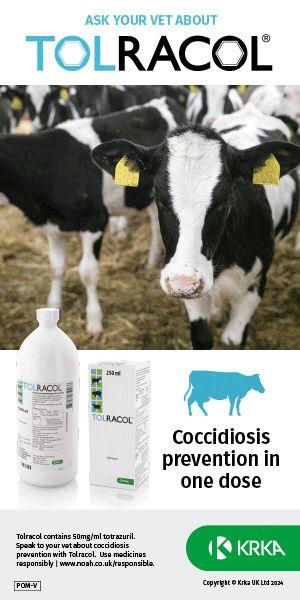Ticks
Ticks (Ixodes ricinus) are not important in cattle except for restricted geographical areas acting as a vector for the occasional case of redwater (Babesia spp) and tick-borne fever (Ehrlichia phagocytophila).
Infestations are seen only in extensively management systems where cattle have access to tick habitats such as rough hill ground. Ticks also infest sheep where they cause tick-borne fever, tick pyaemia, and louping ill.

Tick infestations are seen only where cattle have access to tick habitats such as rough hill ground
The tick life cycle involves egg, larva, nymph and adult stages. The larva, nymph and adult stages feed on the host for only a few days each year, as a larva in the first year, a nymph in the second year and adult in the third year. Ticks can feed on a wide range of host species including sheep and wild animals such as deer.
Treatment
Topical application of either pyrethroid or organophosphate preparations starting before, and re-application throughout, the challenge period is the standard treatment. Control of ticks on sheep in co-grazing systems is also important.
Midges
Bluetongue virus is transmitted by biting midges of the genus Culicoides. Bluetongue virus cannot naturally be transmitted directly between animals. Peak midge populations occur during the late summer and autumn and therefore this is the time when Bluetongue is most commonly seen. It has been estimated that a midge can travel up to 1.5 - 2 km a day in a local area. However, if caught in suitable meteorological conditions midges can be carried much farther distances, especially over water masses of more than 200 km which is why disease in northern France is of particular concern to the UK.
Control of midges has gained interest since the appearance of Bluetongue virus in the UK in 2007. Control of the Culicoides vector can be attempted with pour-on insecticides but this is expensive and does not achieve total freedom from the midge. Vaccination, such as in 2008 when a voluntary vaccination policy against Bluetongue (BTV-8) was introduced in the UK, is highly effective.
Congenital abnormalities in the developing foetus caused by Schmallenberg virus can be prevented by appropriate vaccination.

Bluetongue can be effectively controlled by vaccination rather than by attempting midge (vector) control.
Flies
Head fly
In the UK, the head fly Hydrotea irritans can present a problem during the summer months in cattle grazed near woodland. The horn fly Haematobia irritans can cause intense irritation.

Cows frequently kick at the udder in response to flies feeding on secretions present on the teats.

Self-inflicted trauma to the teats (licking), especially the left fore teat, in response to the muscid fly Hydrotea irritans
Aetiology
During feeding the muscid fly Hydrotea irritans causes considerable irritation which may result in self trauma. Head flies have been implicated in the transmission of bacteria responsible for summer mastitis.

Beef cow with summer mastitis of the right fore quarter. Disease is most common during July/August and associated with fly activity.
Face flies such as Musca autumnalis feed on lachrymal secretions and have been implicated in the transmission of Moraxella bovis the causal agent of infectious bovine keratoconjunctivitis (pink eye).

Face flies such as Musca autumnalis feed on lachrymal secretions.

Early "pink eye" lesion with tear-staining of the face. Infection can spread rapidly through grazing cattle.
Clinical presentation
Grazing patterns are disturbed and affected cattle often isolate themselves and remain in shade where available.
Management/Prevention/Control measures schemes
Ectoparasiticides may be applied topically either as a pour-on technique where the preparation is applied along the length of the dorsum or as a spot-on method where it is applied to a small area on the head or back.
Pour-on fly control preparations, such as high cis cypermethrin or deltamethrin, must be applied before the start of the anticipated fly season. Such treatments should be repeated every three to four weeks during the fly season or as directed by the data sheet instructions.
Ear tags impregnated with high cis cypermethrin may provide season-long fly protection.
Warble flies (Hypodermatosis)
Damage to hides caused by larval stages of Hypoderma bovis and Hypoderma lineatum. Warble fly has been successfully eradicated from the UK where it remains a notifiable disease.
After hatching from eggs laid on the skin during summer months, larvae penetrate the skin and migrate to epidural fat (H. bovis) and submucosa of the oesophagus before reaching the subdermal layer of the dorsum. Large holes are made in the skin during development to third stage larvae during early spring. The larvae emerge, pupate and develop to adults completing the life cycle.
Clinical presentation
Large 2-3 cm larvae present in the subcutaneous tissue along the back of cattle in March-May.
Diagnosis is based upon demonstration of subcutaneous third larval stages. An ELISA test is available to detect migrating larval stages and has been used to monitor national warble fly eradication schemes.
Treatment
Topical organophosphorus treatments, and group 3-ML anthelmintics administered before mid-November to avoid adverse reactions if larvae are killed during their over-wintered sites in the oesophagus/spinal cord.





